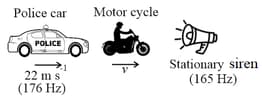B M Sharma Solutions for Chapter: Sound Wave And Doppler Effect, Exercise 2: DPP
B M Sharma Physics Solutions for Exercise - B M Sharma Solutions for Chapter: Sound Wave And Doppler Effect, Exercise 2: DPP
Attempt the free practice questions on Chapter 8: Sound Wave And Doppler Effect, Exercise 2: DPP with hints and solutions to strengthen your understanding. Chapterwise/Topicwise Daily Practice Problems (DPP) Waves & Thermodynamics JEE Main & Advanced solutions are prepared by Experienced Embibe Experts.
Questions from B M Sharma Solutions for Chapter: Sound Wave And Doppler Effect, Exercise 2: DPP with Hints & Solutions
A curve is plotted to represent the dependence of the ratio of the received frequency to the frequency emitted by the source, on the ratio of the speed of observer to the speed of sound , in a situation in which an observer is moving towards a stationary sound source. The curve is best represented by:
The difference between the apparent frequency of a source of sound, as perceived by an observer during its approach, and recession is of the natural frequency of the source. If the velocity of sound in air is , the velocity of the source is (It is given that velocity of source velocity of sound)
Two cars are moving on two perpendicular roads towards a crossing, with uniform speed of and . If the first car blows horn of frequency , then the frequency of the horn heard by the driver of second car, when line joining the cars make angle with the roads, will be
A police car moving at , chases a motorcyclist. The policeman sounds his horn at , while both of them move towards a stationary siren of frequency . Calculate the speed of the motorcycle, if it is given that, he does not observes any beats.

A car is initially at rest, away from a stationary observer. It begins to move towards the observer with an acceleration of , sounding its horn continuously. later, the driver stops sounding the horn. The velocity of sound in air is . The observer will hear the sound of the horn for a duration of
Two persons and , each carrying a source of frequency and , respectively, are standing at rest, a few apart. starts moving towards with a velocity of . If the speed of sound is , which of the following statement is true?

A sound wave of frequency travels horizontally to the right. It is reflected from a large vertical plane surface, moving to the left with a speed . If the speed of sound in the medium is , then study the following statements.
A car moves towards a hill with speed . It blows a horn of frequency , which is heard by an observer following the car with speed The speed of sound in air is .
